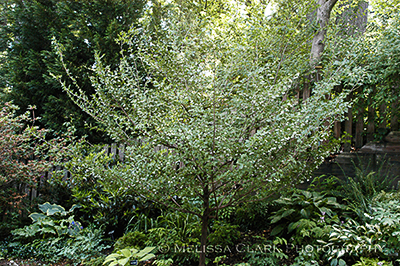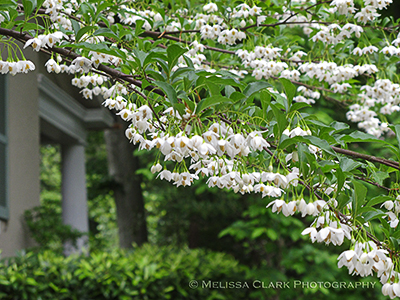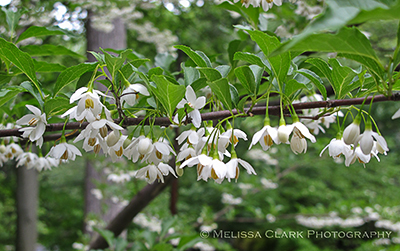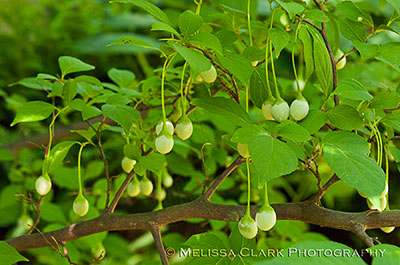The Lovely Snowbell
About a week ago a near-tornado roared through my area, wreaking havoc on trees right and left. It made me think about how important trees are to a garden’s structure and design. Sometimes they are there when you buy the house, providing shade, a focal point, beauty and shelter. Other times, you add them yourself, choosing what you hope will be a successful addition to the garden.
The storm took down two huge branches from my dying American beech tree, but I’ll write about that another time, hopefully later rather than sooner. Today I want to introduce at least some of you to one of my favorite trees for shade, Styrax japonicus, or the Japanese snowbell tree.

A Styrax japonicus, or Japanese snowbell tree, in bloom in my back yard in May. It would stand out more nicely in front of a dark evergreen hedge, but hey, I'm not that disciplined in my own garden.
This portion of my garden, although south-facing, gets only filtered sunlight for most of the day because of the high canopy of the many oak trees in my neighbor’s adjacent yard. Nevertheless, the tree blooms prolifically each May (even when we had our 17-year cicada plague several years ago). The blooms look like small white bells, hanging down from the branch, with the leaves perched above the branch. This habit makes the tree wonderful for planting on a slope or above a small retaining wall so the flowers are at eye level.
In my book, you grow this tree for its flowers and shade-tolerance. The bark is an attractive gray, but its fall color, while sometimes a pleasant yellow, is not particularly showy. It’s also relatively pest-free, grows quickly, and requires no special treatment. Hardy to Zone 6 (and warmer parts of Zone 5), it also comes in a pink-flowered version called ‘Pink Chimes,’ shown below at Brookside Gardens. For something a bit more different, look for a weeping version called ‘Carillon.’
I’ve noticed that as they age, these trees can look a little weedy and be prone to suckering – but that’s nothing that can’t be cured by regular pruning, if necessary. So if you have a shady garden and want an ornamental flowering tree that’s a bit unusual, check out the Japanese snowbell. I don’t think you’ll be disappointed.
Explore posts in the same categories: landscape, photographyTags: D200, D300, design, plants, private gardens, public gardens, spring, trees
You can comment below, or link to this permanent URL from your own site.



August 1, 2010 at 4:09 am
Hello Melissa! Years ago I germinated seed of this tree. I thought I’d planted it out, but either the seed was misnamed or the tags got muddled – or perhaps even it will start to flower somewhere else, and it was merely misplaced. But this aint the tree I think is my Styrax! So what is that tree then?! Thanks for stirring my memory! (BTW – it IS a lovely tree.)
August 1, 2010 at 8:00 am
I’m always impressed by gardeners who grow trees from seeds. I’ve grown hydrangeas from cuttings quite successfully – but a tree! What skill and patience that must take. And now, a mystery for you to identify it. There is another form of Styrax called Styrax obassia – perhaps that’s what you have?
May 30, 2012 at 11:31 pm
Hi Melissa! I just ‘discovered’ this tree in my workplace last Memorial Day as it always smelled sweet around each time I passed by but didn’t know it’s there. Only after smelling all the rhodies around when I finally saw the tree full of white blooms staring at me as if saying ‘hey, I’m up here behind the rhodies’! First time I saw one here in the Northwest so I took photos and a sample to the nursery where the staff identified it as the styrax obassia. They have a couple of the japonicus which are also beautiful but I thought one of the staff said the obassia is more fragrant. Anyway, I bought a small gardenia and brought it to a beautiful friend, her favorite is gardenia though this one has lots of still unopened buds. Anyway, I added in the pot the stem of the fragrant snowbell bloom. She’s very thankful ‘I made her day after having been working like mad’ she said. Such a very hard worker! Been convincing her to take a break from her works and maybe try my favorite Thai restaurant. I’m drifting out of topic here but have to mention her as she’s very lovely, sophisticated and kind like these elegant tree. Makes me wonder if these trees also work very hard like her to stay so awesome. Oh, her name is also Melissa and she’s also a landscape architect. Just mentioning her name feels like being surrounded by the fragrance and that everything will be alright! Thank you Melissa for this lovely site.
August 1, 2010 at 5:51 am
Dear Melissa, As you may imagine, I am entranced by this beautiful tree, my favourite, of course, being the white flowered variety. It has such a graceful habit and, as you say, has interest throughout the year. I do not grow it, but wished I did.
I agree with you entirely about the importance of trees which, in my mind, are the purest form of gardening. Hopefully if people have been unfortunate to lose trees in the storms they will recognise what they are missing and plant more as a result.
August 1, 2010 at 8:02 am
Edith, I like the white-flowered form best myself. And from what I have seen in the short time so far since the storm, our company’s clients and other homeowners are indeed mourning the loss of their trees and planning to replace as many of them as they can.
August 4, 2010 at 4:51 pm
Melissa, a gorgeous, gorgeous tree. I have seen it in books before, but have not come across it for sale at a nursery, what a shame it is a beauty. Sorry to hear about your tree, everytime we get a very strong wind I cringe a bit, scared a tree will come down.
August 7, 2010 at 12:51 pm
Deborah, perhaps it isn’t hardy where you live and that’s why you haven’t seen it in nurseries. I don’t think it can be grown in zones colder than 6.
My beech has an untreatable disease that will probably take it out some time in the next five years – an expensive and very sad prospect to contemplate. In the meantime, it is cabled and the limbs I lost were dead wood. So I keep my fingers crossed.
August 6, 2010 at 6:29 pm
There are several jaw dropping specimens of styrax japonica at Wave Hill gardens in northern Manhattan, and your post reminds me I should put some of those photos up on my blog. When I saw them in bloom in May, all I could say was “why isn’t this tree in my garden??” “Why hasn’t it been there from the beginning??” Thanks for this profile of a lovely tree.
August 7, 2010 at 12:52 pm
Laurrie, thank you for your kind words. I’ve been to Wave Hill but must have missed the styraxes. I would love to see some mature specimens that have properly cared for and lovingly pruned. My own threatens to engulf a narrow pathway in the back yard but is now too old to move.
May 6, 2012 at 3:51 pm
Hi Melissa. I live nearby Brookside Gardens in Wheaton, MD. My wife and I saw a gorgeous Styrax Japonicum Carillon today and fell in love with it. We have a picture postcard size yard in front of our townhouse, lined with azaleas and flowers; this tree seems like it would be a perfect fit. My question to you (and others): Do you have any idea where I can buy one? Thanks for sharing the beautiful photographs!
Regards, Gary
June 8, 2012 at 2:03 pm
Melissa. I planted a Japanese Snow Bell last year in the Spring and it did not bloom this year. Any idea what may be the problem? It is planted in a well drained area with filtered sunlight and it gets watered by the sprinkler system regularly. Tree looks great with abundant new growth this year and has bright green thick foliage so I cannot understand why no blooms when the tree seems to be doing very well?.
June 8, 2012 at 2:08 pm
Gavin, I don’t purport to be an expert when it comes to why a particular tree does or doesn’t bloom. It does sound as though you have a good site for it and that otherwise it is thriving. It’s very possible that since it is so new, this year it is putting its energies into establishing its roots and foliage. Give it another year and see what happens.
June 9, 2012 at 9:43 am
Thanks for the response and I have bought another Japanese Snowbell this year so I will see how that one does in year two .
June 10, 2013 at 12:24 am
We planted one about 3 years ago. It was really doing well, then last year, we noticed the leaves were shriveling and since then almost 1/2 of the tree is dying and bare. Had landscape service treat the trees at end of last year but it doesn’t seem to have helped. It gets full sun and is in the open. Last summer was quite dry. Do you think it was the drought or a pest? We really love it, but it doesn’t look like it is going to make it 😦
June 28, 2014 at 12:03 pm
I grew my styrax from a seedling. It is now about 10 feet tall and very healthy, but it has never flowered! Since I took the seedling from a group of styraxes, I’m wondering if there are males and females?
July 11, 2014 at 10:20 am
Bronwen B. — I also grew my Japanese Snowbell from a seedling, and it got so big in a corner of my garden I had to transplant it to a more permanent location a year or two ago. The spring after transplanting it had beautiful white flowers, but this year none:(. That said, it doesn’t appear that there needs to be a male and female plant present for flowers…this is the only snowbell tree we have. Enjoy yours…
April 28, 2017 at 8:07 pm
Last spring, one of our two Japanese Bell trees started showing a coral pink stain along the trunk. Our arborist thought it was a result of pruning, but it had not been touched. The stain eventually disappeared by summer’s end. This spring, the tree has various of these same stains along some branches and the trunk. After this summer’s hot and dry weather, we injected an organic nutrients into the soil to strengthen the tree. Any ideas of what this could be, and how to treat it. The other tree, located across from it, is not showing any problems.
Thank you!
October 23, 2017 at 2:19 pm
I bought a styrax about six years ago and planted it in a big pot. It has never produced any flowers. Any suggestions why ?
Misanna
October 23, 2017 at 2:56 pm
I’m not a horticulturalist so I’m not able to answer your question. But in general a tree the size of a styrax is probably not well suited to growing in a container. If there are Master Gardeners where you live you might try asking one of them.
May 17, 2018 at 7:30 pm
[…] in early summer is visually invoked by the masses of blooms on Styrax japonicus. Common or Japanese snowbell is the species of Styrax most often grown […]